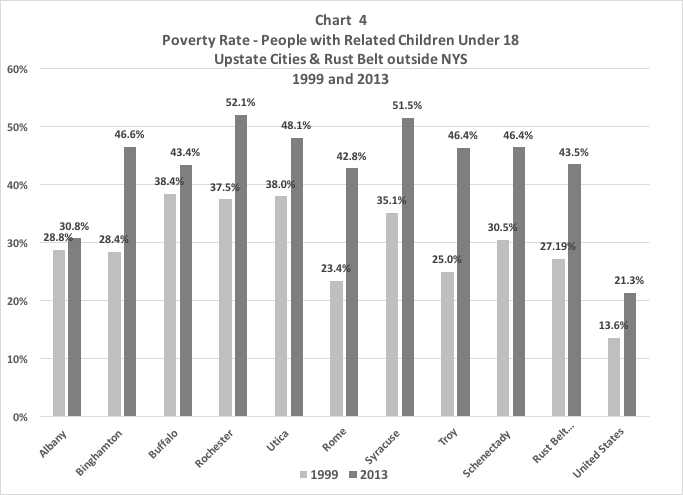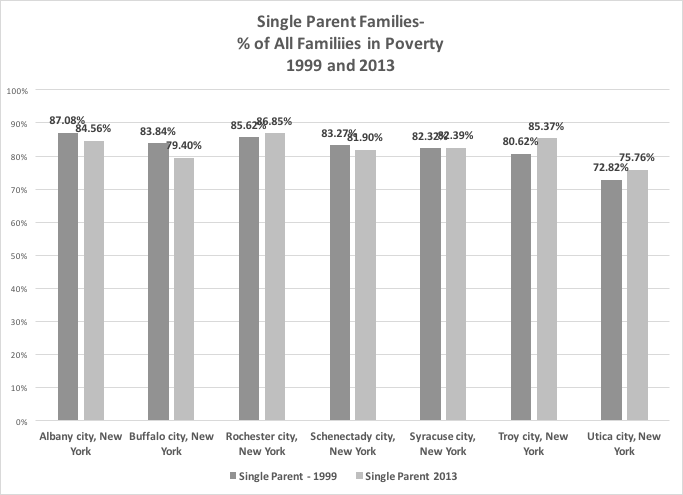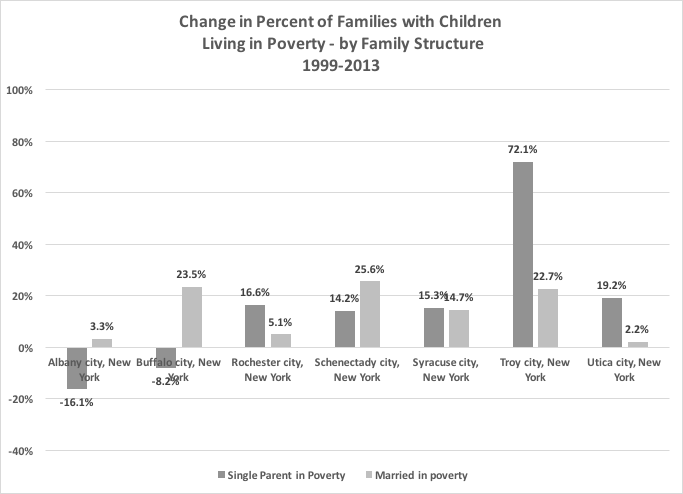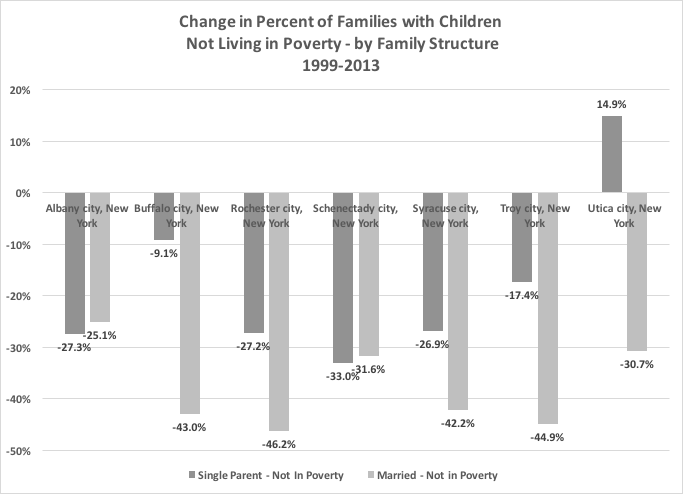In an earlier post, I showed that very high percentages of people with children under 18 lived in poverty in upstate cities, and that the percentage increased significantly between 1999 and 2013. While a few rust belt cities, like Flint and Detroit, Michigan had higher levels of poverty among people with children, poverty in cities like Syracuse, Rochester, exceeded 50%, while in cities like Buffalo, Utica, Binghamton, Troy and Schenectady, it exceeded 40% in 2013. Overall, upstate New York cities had higher percentages of families with children living in poverty than the average for the rust belt. In 1999, less than 40% of people with children in each of those cities lived in poverty.
What most distinguished upstate New York Cities from other cities with high poverty rates was the fact that the suburbs of upstate cities were quite prosperous – particularly compared to the suburbs around other placed, like Flint and Detroit, that had high poverty levels. In fact, only about 11% of residents with children under 18 of counties outside upstate central cities lived in poverty in 2013, less than the average for rust belt counties outside central cities.
 Historically there has been evidence of a strong association between family structure and the likelihood of living in poverty. That relationship has existed in upstate cities, as well. In upstate cities, 70% to nearly 90% of families with children living in poverty were single parent households in both 1999 and 2013.
Historically there has been evidence of a strong association between family structure and the likelihood of living in poverty. That relationship has existed in upstate cities, as well. In upstate cities, 70% to nearly 90% of families with children living in poverty were single parent households in both 1999 and 2013.
Given the fact that the likelihood that single parent families constituted similar percentages of those in poverty in each year, what accounted for the growth of poverty in upstate cities between 1999 and 2013? The answers lie in changes in the concentration of poverty in upstate cities that are associated with population change.
The next chart shows the change in the number of families living below the poverty level in upstate cities:
Each city, with the exception of Albany, saw an increase in the percentage of people living in poverty, and most saw increases both in single parent and married families living in poverty. More significant, however, were the changes in families not living in poverty.
Each city had significant losses in the number of families with children living above the poverty line. Most important here was the change in married families living above the poverty line, since most families above the poverty line have been married families. Each city saw a large decrease in married families above the poverty line – as much as 46% in Rochester, 45% in Troy and 42% in Syracuse. So, the most important factor in understanding the increase in the concentration of poverty in upstate cities is the loss of population above the poverty line. And, since the population decreases were largest in married families living above poverty, upstate cities are increasingly home to single parent families living below the poverty line.
What Can be Done?
While the nation has had success in reducing teen pregnancy nationally, the data from shows that between 1999 and 2013 the percentage of families with children headed by single parents in poverty as a percentage of all families with children sharply increased in upstate cities. Because single parents lack the benefits of two incomes, in many cases, and because of the time challenges faced by single parents in raising children and working, the decline of married households is concerning. Although absent fathers are legally required to provide child support, often both parents live below the poverty line, and the absent fathers lack the resources to meaningfully contribute to the support of their children. So, one basic element of any assistance strategy is to find ways to provide more income to both custodial parents, and the non-custodial partners of the heads of households with children in poverty. Such an approach must focus both on ensuring that adequate government financial assistance is available to meet basic needs, and to help low income parents find better jobs.
The prevalence of single parent families and parents with low levels of education in upstate central cities points to the need to develop support mechanisms for these families and children that will encourage long term goal oriented behavior, and remove obstacles to self-sufficiency. Approaches that should be considered include:
Family centered “Dual Generation” approaches. Current programs and policies often focus on either children or parents.[1] Dual generation approaches focus on parental education and skill development, and childhood learning and development. Several emphasize the impacts of childhood trauma and adverse childhood experiences. See for example,
- Ascend at the Aspen Institute– Gateways to Two Generations: The Potential for Early Childhood Programs and Partnerships to Support Children and Parents Together, Ascend at the Aspen Institute, January 2014. http://b.3cdn.net/ascend/d3336cff8a154af047_07m6bttk2.pdf
- The Anne E. Casey Foundation—A Two Generation Approach to Strengthening Families. Robert Giloth, August 2013. http://www.womenspolicy.org/wp-content/uploads/2013/11/TwoGenerationApproachDRAFT9-24-13.pdf
- Ray Marshall Center – Dual Generation Strategy Initiative— Research Brief. LBJ School of Public Affairs, University of Texas at Austin, February 2012. http://fcd-us.org/sites/default/files/Dual-Gen%20Research%20Brief.pdf
- National Human Services Assembly– Breaking the Cycle of Poverty in Young Families: Two Generation Policy Recommendations. April, 2015 http://nationalassembly.org/Uploads2/Resources/BreakingTheCycleOfPovertyInYoungFamilies.pdf
Promote Married Families: Since there is strong evidence that children living in single parent families do less well in life, promoting married families is an important way to attack one of the major factors associated with poverty. The Brookings/AEI report, “Opportunity, Responsibility and Security” argues, “Political leaders, educators and civic leaders – from both the political left and right – need to be clear and direct about how hard it is to raise children without a committed co-parent.” The report argues for a campaign of similar scope to those used to combat teen pregnancy and the consequences of unplanned sex to encourage marriage.[2]
Birth Control Programs: Another important element of a strategy to encourage delayed, responsible parenting is the use of birth control programs that offer “a range of birth control measures, including long acting forms, and provide the services free…[These programs] can substantially reduce pregnancy rates among sexually active couples, including teen age and low income couples, and enable them to avoid or plan childbearing.”[3]
Strengthen Food Stamp Administration and Benefits: New York State, participation rates in the SNAP (food stamp) program vary significantly, according to data from the New York Times, ranging from 21% of potential recipients in 2009 in Putnam County to 93% in Montgomery County. The wide variation in rates, which averaged about 60% of potential recipients, suggests the need for greater efforts to increase participation, perhaps by moving from county to state administration, or by increasing supervision of county efforts, or by mandating the availability more sites (such as local schools) where in person verification of eligibility is required.[4]
Additionally, there is evidence that the existing food stamp assistance levels create food scarcity among low-income recipients. Benefits under current law are based on the USDA’s “thrifty food plan” which has been criticized for requiring the use of impractical foods, lacks the variety required to meet healthy dieting guidelines, unrealistically assumes adequate facilities and time for food preparation from scratch, unrealistically assumes food availability and affordability in central city locations.[5]
The Urban Institute estimates that increasing the current SNAP benefit by 30% to bring benefits to the USDA low cost food plan level from the thrifty food plan level would reduce child poverty by 16.2%. While the SNAP program is federally funded, New York could supplement the existing federal benefit. Note that the Urban Institute was based on the level of food stamp benefits available from 2009 to 2013, which have subsequently been reduced by 5%, so the actual impact of the proposed increase would be somewhat larger than estimated.[6]
[1] See: Two (or More) Generation Frameworks: A Look Across and Within, Janice M. Gruendel, Ph, D., M. Ed., March, 2014 https://www.cga.ct.gov/coc/PDFs/two-gen/report_gruendel.pdf
[2] “Opportunity, Responsibility and Security,” op. cit. pp. 33-34.
[3] Ibid,
[4]“County-by-County Review of SNAP/Food Stamp Participation, Food Research and Action Center, Washington, DC, http://frac.org/wp-content/uploads/2010/07/ny_times_snap_poverty_formatted.pdf
[5] “Replacing the Thrifty Food Plan in Order to Provide Adequate Allotments for SNAP Beneficiaries.” Food Research and Action Center, Washington, DC, 2012. http://frac.org/pdf/replacing_tfp_to_provide_adequate_snap.pdf
[6] Reducing Poverty in the United States – Results of a Microsimulation Analysis of the Community Advocates Public Policy Institute Policy Package, Kye Lippold, Urban Institute, March 2015. http://www.urban.org/sites/default/files/alfresco/publication-pdfs/2000151-reducing-poverty-in-the-united-states.pdf


